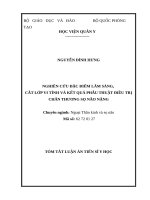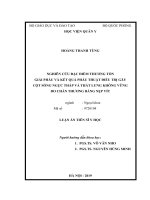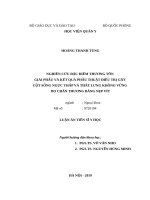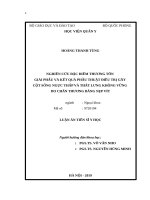Đặc điểm hình thái tổn thương và kết quả phẫu thuật điều trị gãy cột sống ngực, thắt lưng đa tầng tt tiếng anh
Bạn đang xem bản rút gọn của tài liệu. Xem và tải ngay bản đầy đủ của tài liệu tại đây (223.64 KB, 34 trang )
MINISTRY OF EDUCATION
AND TRAINING
DEFENSE
MINISTRY OF
NATIONAL
MILITARY MEDICAL UNIVERSITY
LE HUU TRI
MORPHOLOGICAL CHARACTERISTICS OF
MULTILEVEL THORACIC AND LUMBAR
VERTEBRAL FRACTURE AND THE
EFFECTIVENESS OF SURGICAL TREATMENT.
Speciality: Surgery
Code: 9720104
SUMMARY OF MEDICAL THESIS
HA NOI - 2020
THESIS IS COMPLETED AT
MILITARY MEDICAL UNIVERSITY
Supervisor:
1. Associate Prof. PhD. Vu Van Hoe
2. Associate Prof. PhD. Vo Van Nho
Reviewer 1: PhD. Hoang Gia Du
Reviewer 2: Associate Prof. PhD. Bui
Van Lenh
Reviewer 3: Associate Prof. PhD. Nguyen
Tho Lo
The thesis will be defended by University’s Council at:
The thesis can be found at:
1. National Library
3
INTRODUCTION
Multilevel noncontiguous spinal fractures (MNSF) are
defined as fractures of the vertebral column at more
than one level. According to many reports, multilevel
noncontiguous spinal fractures are found at from 3.2%
to
16.7%.
Multilevel
spine
injuries
are
often
uncommon, occur commonly as a result of high-speed
road traffic accidents or falls from a height. Multilevel
spine injuries tend to be more severe than unilevel
because of the other injuries combined. Rapid diagnosis of
MNSF is essential since a misdiagnosis or delayed diagnosis may
complicate the clinical picture. Therefore, the role of a
thorough physical and radiological examination is the
key to not to miss any lesions. Although there are
many studies evaluating and treating single level spine
fractures, there have not been many reports of
multilevel spine injuries. In Vietnam, there are not
many researches on this issue. So we work for:
“Morphological characteristics of multilevel thoracic and
lumbar vertebral fracture and the effectiveness of surgical
treatment” with these targets:
1. Describing the morphological characteristic of
multilevel
fractures
thoracic
in
which
and
lumbar
surgical
vertebral
treatments
are
indicated at Da Nang Hospital.
2. Evaluating the outcome of surgical treatment
for multilevel thoracic and lumbar vertebral
fractures at Da Nang Hospital.
4
-
New main scientific contributions of the thesis:
The research subjects are lesions in multilevel thoracic
-
and lumbar vertebral fractures
Providing the evidence of the effectiveness of surgical
treatment for multilevel thoracic and lumbar vertebral
fractures
- Structure of the thesis: the thesis includes 127
pages with 40 tables, 27 pictures and 10 charts.
Introduction (2 pages); Chapter 1: Overview (31
pages); Chapter 2: Subjects and Methods of the
study (26 pages); Chapter 3: The results of the
study (31 pages); Chapter 4: Discussion (33
pages); Conclusion (2 pages); Petition (1 page);
List of published articles related to the results of
the thesis (1 page); References (138 documents
including
33
documents
in
Vietnamese,
105
documents in English); The appendices.
SECTION 1
OVERVIEW
1.1.
A
brief
history
of
treatment
of
spine
fractures.
1.1.1. In the world
Multilevel spine injuries have been reported for a
long time. Griffith H.B., Gleave J. R. W, Taylor R. G.
(1966) reported 5 patients accounting for 3.2% of 155
cases of thoracic and lumbar spine fractures. Lizbeth
5
C. A. M. G. et al. (2018) reported 47 cases of multilevel
spinal surgery at the Center Dr. Manuel Dufoo Olvera
in Mexico. Thus, the multilevel spine fractures have
been studied for a long time, but they are still
separated. There are no single reports on multilevel
spinal injuries.
1.1.2. In Vietnam
Previous studies inside the country have only
studied one-level fractures, there were some authors
who mentioned several cases of multilevel spinal
injuries.
And
there
are
no
separate
studies
on
multilevel thoracic and lumbar spinal injuries.
1.2. Classification of multilevel thoracic and
lumbar veterbral fractures
1.2.1. Classification of Denis
In 1983, Denis introduced the definition of "threecolumn spine": the anterior, middle and posterior
column; and it has been widely applied.
1.2.2. Classification of Margel (AO)
In 1994, Margel proposed a classification according
to AO (Arbeitsgemeinschaft fur Osteosynthesefragen)
which mainly assess spinal morphological damage.
1.2.3. Load Sharing Classification (LSC)
In 1994, Mc Cormack and colleagues released a new
classification to assess vertebrae damage based on
three criteria: the amount of damaged vertebral body,
the spread of the fragments in the fracture site, the
amount of corrected traumatic kyphosis.
6
1.2.4. Classification of multilevel thoracic and
lumbar spinal injury based on the severity of
lesion.
In
2005
Vaccaro
A.R.
et
al.
proposed
a
Thoracolumbar Injury Classification and Severity Score
(TLICS) which is is based on three major categories,
known as parameters: injury morphology, posterior
ligamentous complex integrity, patient neurology.
1.4. Imaging Tests
1.4.1. X-ray
X-rays are the fastest technique to assess the
overall picture of the spine and bone anatomy.
- To locate lesions.
- To identify changes in the overall spine: angulation,
displacement,
spondylolisthesis,
and
rotation
by
evaluating over 3 lines in a straight posture (spinous
process line, pedicles line and lateral border).
- To measure local Kyphotic Angle (LKA) and Cobb
Angle.
1.4.2. Computed Tomography Scan.
Computed tomography (CT-scan) provides greater
details and resolution for evaluation of the bone
elements and assessment of the entire spinal canal.
CT-scan allows us to assess bone lesions, fracture
lines, fracture fragments, lesions of processes, joints,
holes, posterior arcs, damaged fragments moving into
the spinal canal, and spinal stenosis.
1.5. Methods of Spine Stabilization.
1.5.2. Posterior Stabilization Systems
7
Posterior stabilization systems can restore vertebral body height
by distraction forces. Furthermore, anterior and middle columns
maintained their normal length during correction of kyphosis.
Distractive forces provided by the posterior stabilization system
developed a tensile strength in the posterior longitudinal ligament
which pushes back the retro-pulsed bone fragments forward. This
process has been termed ligamentotaxis and it is beneficial
particularly if performed at the early period.
1.5.2.3 Posterior lumbar interbody fusion surgery
(PLIFs).
Transpedicular screw is now the standard of spine
fusion surgery for many spinal diseases. We use a
"free hand" technique with screws are parallel to the
joint of the vertebra and we use X-rays for guiding
during surgery.
1.6.
Indications
of
surgical
treatment
for
multilevel thoracic and lumbar fractures
Greenberg
M.S.
(2010)
refers to
a
treatment
indication based on a clear, complete description of
the morphological characteristics of lesions in three
columns, signs of neurological damages and their
associations. They also consider the characteristics of
the fracture group as well as the location of fractures
in assessing the instability of the injury. In this
document,
author
McAfee
presents
the
specified
surgery in the case.
1.7. Evaluation the results of surgical treatment
1.7.1. The assessment of the results of spinal
correction and stabilization surgery
8
Anteroposterior (AP) and oblique X-rays on all patients;
measuring local LKA and Cobb Angle on oblique X-rays
is the most commonly used method today.
1.7.2.
The
assessment
of
the
neurological
recovery after surgery
Based on the neurological damage classification
table according to Frankel: Pre-operative evaluation,
post-operative evaluation, and evaluations in follow-up
visits, monitoring changes in Frankel level between two
consecutive visits.
CHAPTER 2
SUBJECTS AND METHODS OF STUDY
2.1. Subjects
2.1.1.
The criteria for selecting research patients
- All patients diagnosed with multilevel vetebral
fractures (≥ 2 levels) from the fourth thoracic vertebra
to the fifth lumbar vertebra, having unstable fracture,
and caused by trauma. These include multilevel
vertebral fractures emphasized on thoracic-thoracic,
thoracic-lumbar, and lumbar-lumbar segments.
-All patients who have plain and oblique X-rays,
computerized
tomography
scan
and
posterior
stabilization of at least one fractured vertebra body.
2.1.2. Exclusion criteria
-Elderly patients with osteoporosis, bone tumors,
tuberculosis, cardiovascular disease, coagulopathy,
9
etc. Patients with brain sequelae or brain entity
pathologies, spinal cord sequelae or paralysis of
peripheral nerves in the lower extremities due to
pathology,
mental
disorders
that
distort
nerve
assessment at the spinal cord. Patients who had
surgery then lost information, did not come back for
examination, or did not cooperate with treatment.
2.2. Research method
2.2.1. Sample size
Convenience
sampling
method,
including
all
patients who match selection and exclusion criteria
during the research period.
2.2.2. Method of data collection
Clinical and radiological findings : routine X-ray, CTscan; the results of treatment are collected based on a
pre-set form. Direct clinical examination, assessment
of symptoms, analysis of results of X-rays, CT scans
before surgery.
Perform posterior stabilization surgery, evaluate the
postoperative results. All patients receive discharge
instruction in self-care and mobilization.
Re-examination after 06 months: examination of
clinical symptoms such as movement on ASIA scale,
sensation, reflexes, urination, incisions, neurological
recovery according to Frankel level, urinary tract
infections, pneumonia, muscle atrophy, regular X-ray
10
measuring KLA, height of fractured vertebra, screw
position.
2.3. Method of Data Analysis
Collected data were processed in the statistical
software 12.2.1.0.
11
CHAPTER 3
RESEARCH RESULTS
3.1.
Clinical
and
multilevel
radiological
thoracic
characteristics
and
lumbar
of
vertebral
fractures.
3.1.1. General characteristics
3.1.1.1. Age, gender, occupation
Age group 20-19 accounted for the majority of cases
with 19 patients (35.84%). The youngest age 16, the
oldest
age.
Average
age
was
37.47
±13.47.
Male/Female ratio: 4.88/1.
Workers accounted for the higest rate with 26
cases (49.05%). The majority were workers and
freelancers with 36 cases, accounting for 67.85%.
3.1.2.
Clinical
conditions
of
patients
on
admission
3.1.2.6. The degree of nerve damage according to
Frankel
Table 3.5. Patient classification according to Frankel
neurological damage
Frankel
A
B
C
D
E
Total
No.
Patients
(n)
10
2
7
4
30
53
Percentag
e (%)
18.86
3.77
13.20
7.54
56.63
100
p<
0.01
12
13
3.1.2.7. The associated injuries
Table 3.6. The associated injuries
Associated
lesions
No
Abdominal
trauma
Thoracic Trauma
Head Trauma
Extremity
Fractures
No.
Patients
(n)
17
2
Percenta
ge (%)
7
3
7
32.07
3.77
p<
0.01
13.20
5.66
13.20
3.1.3. Radiological findings
3.1.3.1. Detect vertebral lesions on regular X-ray and CTscan
In 53 cases of MNSF, CT-scans revealed 118
fractured vertebrae. The number of cases with 2
broken vertebrae accounted for the highest proportion
with 44 patients (83.01%), and with 4 fractures or 5
fractured vertebrae was 1 patient accounted for
1.88%.
3.1.3.2. Distribution of multilevel vertebral fractures
Chart 3.7. Distribution of multilevel vertebral fractures
3.1.3.4. Detecting contiguous or noncontiguous lesions
on CT-scans
Chart 3.8. Detecting contiguous or noncontiguous
lesions on CT-scans
14
3.1.3.6. The fragment of bone causing spinal stenosis
on CT-scans
Chart 3.9. Spinal stenosis
3.1.9.
The
correlation
between
clinical
and
radiological findings
Table 3.16. The correlation between Denis
classification of spinal fractures and
The Frankel Grade classification
Denis
Compressio
n fractures
Burst
fractures
Total
n, (%)
Frankel
A
B
C
D
E
0
0
0
0
4
4 (7.54)
4
2
5
4
23
38
(71.69)
p=
0.031
9
15
Seat-belt
fractures
FracturesDislocation
Total
n, (%)
0
0
0
0
2
2 (3.77)
6
0
2
0
1
9 (17.00)
10
2
7
4
30
(18.8 (3.7 (13.2 (7.5 (56.6 53 (100)
6)
7)
0)
4)
3)
3.1.10. The correlation between neurological
damage and degree of spinal stenosis on CTscan
Table 3.17. The correlation between degree of spinal
stenosis and degree of paralysis
Fragme
nt of
bone
Frankel
A
B
C
D
E
Non
spinal
0
0
0
0
8
stenosis
Spinal
stenosis
2
0
2
1
16
< 50%
Spinal
stenosis
8
2
5
3
6
≥ 50%
Total
10
2
7
4
30
n, (%) (18.8 (3.7 (13.2 (7.5 (56.6
6)
7)
0)
4)
3)
Total
n,
(%)
p<
0.05
8
(15.0
9)
21
(39.6
3)
24
(45.2
8)
53
(100)
3.2. Surgical results
3.2.1. Surgical factors
3.2.1.1. Time of surgery
Surgery within 3 days after accidents (72 hours)
only had 8 cases (15.08%), after 3 days accounting for
16
84.92%. The earliest time from admission to surgery
was within 1 day, the longest time from admission to
surgery was 21 days. Average time 7.37 ± 4.37 days.
3.2.1.6. Overlapping surgeries
Table 3.23. Overlapping surgeries
No.
Patients
(n)
1
4
6
Overlapping
surgeries
Cranial surgery
Thoracostomy
Fracture Fixation
Thoracostomy +
Fracture Fixation
Total
Percent
age (%)
1.88
7.54
11.32
3
5.67
14
26.41
p<
0.01
3.2.2. Surgical results
3.2.2.1.
Results
of
neurological
operation
recovery
after
according
to
The Frankel Grade classification
Table 3.24. Neurological recovery after operation
Frankel
A
B
After
Operatio C
n
D
E
Total
Total
Preopration
n, (%)
A
10
B
0
C
0
D
0
E
0
0
1
0
0
0
10
(18.86%)
1 (1.88%)
0
0
3
0
1
4 (7.54%)
0
1
2
1
0
4 (7.54%)
0
0
2
3
29
10
2
7
4
30
34 (64.18
%)
53
(100%)
n, (%) (18.8 (3.7 (13.2 (7.5 (56.
6%)
7%)
0%)
p<
0.000
1
4%) 63%
)
3.2.2.3. Results of neurological recovery after re-examination
17
The Denis Pain and Work Scale: there were 17
graded level 1 patients (32,07%) who were able to
return to work and 12 graded level 5 patients (22,66%)
completely lost working capacity.
Table 3.27. Neurological recovery after 6 months
Post operation
Total
n,
(%)
Frankel
A
10
B
0
C
0
D
0
E
0
0
1
0
0
0
0
0
1
0
0
0
0
3
0
0
0
0
0
4
34
10
(18.86
%)
1
(1.88
%)
4
(7.54
%)
4
(7.54
%)
34
(64.18
%)
A
B
Reexami
ned
C
D
E
Total
n, (%)
p<
0.00
01
10
(18.86%
)
1
(1.88%)
1
(1.88%)
3
(5.66%)
38
(71.72%
)
53
(100%)
3.2.2.4. The result of local kyphosis angle recovery
results
Table 3.28. Local kyphosis angle recovery results
Local
kyphosis
angle
Lowe
st
High
est
Mean
Preoperation
50
42
0
18.73 ± 7.380
(1)
Postoperation
10
27
0
10.56 ± 5.530
(2)
Reexamination
20
29
0
13.37 ± 5.940
(3)
Compare
(p)
p12<
0.0001
p13=
0.0001
p23=
0.0132
18
19
3.2.2.5. The results of vertebral body compression recovery after
surgery
Table 3.30. Anterior Vertebral Body Compression
Percentage Results
Index
Anterior
Vertebral
Body
Compressio
n
Percentage
(%)
Preoperation
(1)
Postsurgery
(2)
ReCompare
examinati
(p)
on (3)
38.52 ±
17.81
24.92 ±
16.03
25.30 ±
16.03
p12=
0.0001
(7.1689.39)
(0.0867.02)
(1.5976.31)
p13=
0.0001
p23=
0.9031
3.2.2.7. Overall results
Table 3.32. Overall Results
Result
No.
Patients
Percentage
(%)
Good
38
71.69
Fair
2
3.76
Average
12
22.67
Bad
1
1.88
Total
53
100
p<
0.0001
20
CHAPTER 4
DISCUSSION
4.1. Clinical and radiological characteristics of
multilevel
thoracic
and
lumbar
vertebral
fractures
4.1.1. General characteristics
4.1.2.6. The degree of neurological injuries according
to the Frankel Grade classification
In table 3.5 we find that patients with normal
sensory and motor function (Frankel E) accounted for
the highest proportion with 30 cases (56.63%). The
number of patients with symptoms of complete
paralysis (Frankel A) ranked second with 10 patients
(18.86%).
The rate of paralysis varies by author, depending on
research subjects.
4.1.2.7. Associated injuries
Patients with multilevel spinal injuries were mostly
caused by a complex, strong traumatic mechanism,
which often resulted in other traumas. Patients with
other accompanied injuries accounted for the highest
proportion with 36 cases (67.93%), in which multiple
injuries ( 2 types of combined injuries or more) had 11
patients (20.78%).
Our research had a high percentage of combined
21
injuries due to the strong traumatic mechanism of
multilevel spinal injuries that caused damage to
organs of the body.
4.1.3. Radiological findings
4.1.3.1. Detection of vertebral lesions on regular X-ray
and CT-scan
In all cases where only one fractured vertebra was
detected on X-rays, more than one fracture was
detected on CT-scans. CT-scans revealed 118 fractures
in 53 cases. (ratio: 2.22 fractures/1 patient).
Reasons for missing lesions on X-ray films: poor
image quality, not capturing the entire spine at our
request,
initial
examinations
by
inexperienced
physicians.
This shows that lesions will be more accurately
detected in CT-scanned patients than in patients with
x-rays only. This is considered the best method for
assessing lesions of bone today.
4.1.3.2. Distribution of lesions of multilevel spinal
fractures.
Figure 3.7 shows that the most common segment
among all patients suffering multilevel spinal fractures
were concentrated in thoracic+thoracic segment with
11 cases (20.76%), thoracic+lumbar segment and
lumbar+ lumbar segment with 21 cases (39.62%).
Most injuries emphasized on the thoracic+lumbar
segment and lumbar+ lumbar segment because
these segments are mobile vertebrae that are prone to
22
injury. And the thoracic segment has protection of the
ribs and back muscles so it is less vulnerable.
We found that the lesions in two separate sections
of lumbar and thoracic spine accounted for a relatively
high proportion (39.62%). Therefore, we recommend
that in case of multiple injuries, it is essential to have a
careful examination and X-ray of the entire spine to
avoid
missing
multilevel
noncontiguous
spinal
fractures to prevent complications from errors of
omission.
4.1.3.4. Detection of contiguous or noncontiguous
fractures on CT-scan
Figure 3.8. showed that there were 36 patients with
contiguous fractures, accounting for a high rate of
67.93% and 17 patients with non-contiguous fractures
(32.07%).
The rate of fracture detection in our study is
relatively high compared to other previous reports,
probably because our hospital is a general hospital,
not a specialty hospital. We not only treat spinal
injuries but also treat other injuries such as thoracic,
abdominal,
or
extremity
fractures;
and
more
importantly, our hospital has intensive unit care which
is essential for treatment of patients with severe
injuries. Therefore, most of traumatic cases were
admitted to our hospital.
23
4.1.3.6. The fragment of bone causing spinal stenosis
on CT-scan
Figure 3.9 shows that fragments of bones causing
spinal stenosis> 50% were 21 patients, accounting for
39.63%. Bone fragments causing spinal stenosis ≥ 50%
were 24 patients, accounting for 45.28%. This suggests
that the majority of patients with multilevel spinal
injuries due to a strong, complex trauma often have
severe spinal stenosis.
4.1.9.
The
correlation
between
clinical
and
radiological findings.
Table 3.16 shows the relationship between lesion
images on CT-scans and clinical features. The number
of patients with spinal fractures accounted for the
highest proportion with 38 cases (71.69%), followed by
fracture-dislocations with 9 cases (17%), in which
paralysis caused by fracture-dislocations accounted for
the highest rate with 8/9 cases ( 88.88%).
The number of cases of vertebral fractures showing
signs of neurological lesion were 15/38 patients,
accouting for 39.47%.
Neurological lesions were more common in the
fracture-dislocations of spine, which is also reasonable
due to the fact that the most common anatomical
lesions
in
the
compression
fractures
and
the
dislocations are worse than in the other two groups.
Evaluation
of
neurological
lesions
in
diagnostic
imaging was determined only on magnetic resonance
24
images. In our study, there was no pre-surgery MRI,
which was also the problem of the study.
4.1.10. The correlation between neurological
lesions and the degree of spinal stenosis on CTscan
Table 3.17 shows that 8 out of 10 patients with
paralysis (80%) had spinal stenosis of 50% or more, 2
patients with Frankel B (100%) had spinal stenosis of
50% or more.
5 out of 7 patients with Frankel C
(71.42%) had spinal stenosis of 50% or more. Thus,
the majority of patients with spinal stenosis of 50% or
more had more severe neurological lesions. There was
a correlation between the degree of spinal stenosis
and
the
degree
of
paralysis.
This
relevance
is
statistically significant.
This is a problem that many authors are interested
in finding the link between spinal stenosis and
neurological lesions. Several studies have shown that
fragments of bones narrowing the spinal canal are the
causes of neurological lesions.
This study also shows that CT has great value in the
diagnosis of spinal stenosis, but CT has certain
limitations, making it difficult to assess ligament and
disc injuries.
4.2. Surgical Results
4.2.1. Surgical factors
4.2.1.1. Time of surgery
Table 3.18 shows that there was only patient had
25
surgery within 1 day (24 hours), accounting for 1.88%.
The longest time from admission to surgery was 21
days. The majority of patients had surgery after 3
days, accounting for 84.92%. Average time 7.37 ±
4.37 days.
In our view, in multilevel spinal injuries, there are
many other injuries accompanied. The first hours or
the first day after injury is the stage of spinal shock if
the patient has spinal cord injury. At this stage it is
difficult to fully assess the neurological lesions, so the
prognosis and determination of surgical approaches
are difficult to avoid shortcomings, or errors. Surgery
should be performed after 3 days because at this time
the status of spinal shock and other injuries is stable.
Furthermore, at this stage, neurological lesions can be
clearly identified clinically, accompanied by imagining
findings and laboratory tests.
4.2.1.6. Overlapping surgeries
Table 3.23. showed that 14/53 cases (26.41%) had
overlapping trauma surgeries, of which 6 cases had
fixation surgeries, accounting for 11.32%; and 3 cases
were accompanied by surgeries for thoracostomy +
fixation surgery.
The rate of our overlapping surgeries is relatively
high, which means that the majority of multilevel
spinal injuries have other accompanied injuries and
even require surgery. Multilevel spinal injury is a
severe injury.









